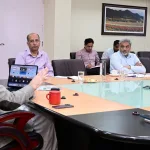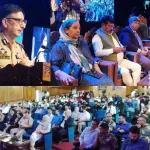The Union Territory of Jammu and Kashmir falling in the great north-western complex of the Himalayan ranges having a geographical area of 42,241 Km2 is predominately agriculture based economy. About 70% of population is directly or indirectly engaged in agricultural and allied occupations. About 60% of area under agriculture in the UT is rain fed with frequent moisture stress. The size of holdings in this region is largely marginal and small (less than two ha). The two regions of the UT have a distinct climate and cropping pattern. The average land holding in the erstwhile state of J&K a few years back was 0.67 ha. While the major cropping systems in the valley are rice-mustard and rice-oat (fodder); in Jammu region, the predominant cropping systems are rice-wheat and maize-wheat in irrigated and rain fed areas respectively. The farming systems in Kashmir are mostly horticulture based and the important fruits grown here are apple, walnut, apricot, etc. With a vast natural resource base, varied agro-climatic conditions and an ideal climate for different crops, agriculture and allied sectors have played and a lot to play in its economy, employment and livelihood security of its populace.
The consumption requirements of food grains exceed the total production of food grains in the UT; as a result of which it has to depend on food grains from other states. The productivity of crops here is low as compared to national average. A host of factors can be attributed to this low productivity. The agriculture sector here is constrained by its rainfed regions, its hilly terrain, predominance of small and marginal holdings, fragile soils, low level of farm mechanization, mono cropping pattern more so in temperate and high altitude areas, low level of food processing and value addition, a chemical intensive agriculture, farmers’ exclusiveness and many others.
To overcome these constraints and to devise a roadmap for holistic development of Agriculture and allied sectors in Jammu Kashmir, Administration of Union Territory has come up with an Apex Level Committee (UTALC) for holistic development of agriculture and allied sectors. The eight member committee assisted by different Technical Working Groups (TWG) is being headed by Dr. Mangla Rai, Former DG, ICAR and comprises of Dr. Ashok Dalwai, CEO, National Rainfed Area Authority (NRAA); Sh. Atul Duloo (IAS) FC/ACS, APD UT of JK, Dr. P. K. Joshi, Secretary, NAAS, Pusa, New Delhi, Dr. Prabhat Kumar, Horticulture Commissioner, Agriculture and Farmer Welfare Department, MoA & FW GoI, Dr. H. S. Gupta, Former Director, IARI. The high level committee also includes the Vice chancellors of two farm varisties of UT of Jammu and Kashmir Prof. (Dr.) J. P. Sharma, HVC, SKUAST-Jammu and Prof. (Dr.) Nazir Ahmed Ganai, HVC, SKUAST-Kashmir. Prof. (Dr.) N. A. Ganai is the member secretary of the high level apex committee.
The goals and targets for next five years set up by UTALC include doubling contribution of Agri-GDP in next five years from $4 billion to $8 billion, meeting 100% SRR with quality seeds, doubling resource use efficiency from 30% to 60% in respect of nutrients and moisture by bringing in advance technologies; reducing food wastage to 1/3 (10%) through proper post harvest management by building suitable infrastructure (CA stores, pack houses, refrigerated transport) and food processing; tripling of food processing from 5% to 15% by focusing on secondary agriculture; building capacity to meet the requirements of the quality planting material; establishment of 300 functional and profitable FPOs in 20 districts of J&K; avail Agriculture Infrastructure Fund of rupees 900 crore reserved by GoI for JK UT; vocational skill trainings to 2000 youth annually for next five years; build state data banks using artificial intelligence and ICT tools for Apple, Dairy and small ruminants in next five years; reduce the use of agrochemicals by 25% in next five years. The deadline for this is five years.
Doubling Resource Use Efficiency
Resource use efficiency means using the limited resources in a sustainable manner and at the same time minimising impacts on the environment. It creates more with less and delivers greater value with less input. Doubling resource use efficiency from 30% to 60% will need modification of agronomic practices along with adoption of conservation agriculture practices like system of rice and wheat intensification and organic/natural organic farming, crop residue management, water conservation, development of climate tolerant crop varieties etc. Use of ICT and Precision Farming technologies also aid in doubling resource use efficiency in agriculture and allied sectors.
Quality Planting Material
Planting material is a basic and critical input for agricultural production. Inadequate availability of quality seeds, planting materials and germplasm are major constraints limiting productivity. Quality Planting Material is ‘the production of uniform, healthy, disease-free planting material raised through seed or vegetative methods with an overall goal to raise the physiological and Phyto-sanitary quality of the plant available to stakeholders to increase productivity’. In order to meet the demand of quality planting materials it is necessary to upscale the production of planting materials from the departmental farms or by involving private stakeholders.
Reducing Food Wastage
About one third of food produced is spoiled or squandered before it gets consumed. This also represents a waste of the human labour, water, energy, land and other inputs that went into producing that food. In the next five years the food wastage has to be brought down to one third of the present through proper post harvest management by building adequate infrastructure and food processing. This will require creation of adequate infrastructure related to storages, pack houses, refrigerated vans and conveyance. The GoI has also recognized the need for this and is providing various type of support for infrastructure development. Operation Green launched by GoI also provides subsidy to the producers in transport charges for perishable items. Funds under Agri-infrastructure Fund can be utilized for this purpose also.
Doubling Contribution of Agriculture in GDP
The Agri-GDP in the UT has to be increased from $ 4 billion to $8 billion in the next five years. In Jammu Kashmir over the last five decades, the share of primary and secondary sectors in the GDP has declined while as the share of service sector has increased. This may be due to the agriculture sector not receiving the impetus or scale of finance as required for its growth. Now with liberal funding from the centre and roll out of various farmers and pro-farming policies and programmes like PMKISAN, PMKBY, PMKSY; things are definitely going to change. The only thing is to ensure inclusiveness.
Availing Agri Infrastructure Fund (AIF)
AIF is a medium long term debt financing facility by Government of India for investment in viable projects relating to post-harvest management infrastructure and community farming assets through incentives and financial support in order to improve agriculture infrastructure in the country. The government of India has reserved an amount of rupees 900 crore under AIF for UT of Jammu and Kashmir. Post harvest processing is very low in the country. Fund under the AIF can be used to augment the food processing infrastructure to increase the level of Food Processing in the UT from 5% to 15% as envisaged by the apex level committee.
Data Banks
The data forms the basis for effective planning and prioritising. We have abundance of data regarding agriculture sector collected from an array of diverse sources, but unfortunately we have not been able to generate reliable knowledge effectively out of this data to use it for furthering the development of communities engaged in this profession. We need to organize, synthesize, categorize and systematize the data pertaining to the farming community in an order where it would have been easier to identify them, to ensure that they are well informed and are benefitted. All this also need to be done with the aim to increase farmers’ income by leveraging the available data and developing solutions based on the data so that the input costs are reduced, ease of farming is ensured, quality is improved and farmers get better price for their farm produce. The Ministry of Agriculture and Farmers’ Welfare, Government of India is already working on an innovative solution to the problems of the farming community based on the data of the farming community through ‘Agri-stacking’. Similar sort of approach can be taken for agriculture and allied sectors in this UT.
Seed Replacement Rate (SRR)
Seed constitute a very critical input for improving the production and productivity on a sustainable basis, improving SRR is must. Desirable SRR of 25% for self pollinated crops, 35% for cross pollinated crops and 100% for high yielding varieties at the national level has now been revised to 33% for self pollinated crops and 50% for cross pollinated crops. In case of Jammu and Kashmir the data available reveals a SRR of 33% in Kashmir and 26.2% in Jammu for rice, 24% in Kashmir and 32.1% in Jammu for Maize, 32% in Kashmir and 35% in Jammu for fodder grown in ‘rabi’ season. More can be done by creating ‘seed villages’ building seed multiplication chains in Public Private Partnership mode or through creating a pool of private entrepreneurs.
Farmer Producer Organizations (FPOs)
Giving equal representation to each district in the formation of FPOs means formation and promotion of 15 FPOs in each district of the 300 FPOs to be formed in next five years. It is definitely a good move to mobilize the farming community and connect them to the markets. As the FPOs will also be formed on ‘One District, One Product’ approach, there is a lot of scope for branding, certification and promotion of many niche, traditional and forgotten crops. This in turn will definitely prove to be a milestone in augmenting farmers’ income ultimately leading to their empowerment.
Skill Development
According to the Centre for Monitoring Indian Economy (CMIE), the UT of Jammu and Kashmir has the greatest unemployment rate in the country. It was 25 percent for the month of March, 2022. This was despite the national unemployment rate witnessing a decline. The rising unemployment rate in the UT continues to be a lingering problem for the youth. Government jobs cannot be given to all and as such skilling the youths followed by their handholding to enable them to set up their own ventures seems to be the most promising option. The two farm varisties of the UT are already on the job providing skill related training in agriculture and allied sectors through various programmes like Skill Training of Rural Youths, Agri clinics and Agri business centers, Attracting and Retaining Youths in Agriculture, Agri business incubators and others.
Reducing the Use of Agro-Chemicals
The use of agro-chemicals has posed severe threat to agriculture and allied sectors; environment and its resources and to the human health. Their abundant use has also deteriorated soil health and its texture. Himalayas in India are mostly rich in horticultural products and during 2015-16, it was recorded that over 20,000 people died due to pesticide self-poisoning by committing suicide. The use of agriculture in the UT has to be reduced by 25% in the next five years. The UT is already on the move towards making it organic. At once it cannot be done as it runs the risk of getting food scarce. Of course it can be done in stages. In the first stage a certain percentage of area where agro-chemicals can be substituted by various organic control treatments can be taken up.
Food Processing
The poor infrastructure and investment in agro-processing sector hinders the overall output of various high value crops in this UT. In the new paradigm, the level of food processing has to be tripled to 15% from present 5%. It has to be done by focusing on secondary agriculture. Agriculture generates raw materials that meet basic human requirements and is considered as a primary economic activity. When the raw produce is processed, it gains additional value and is referred to as secondary agriculture. The largely small and marginal farmers dominated agro-processing sector in this UT is characterized by labour intensiveness and small unorganized industries that lack capital investment and are devoid of any market linkages. Food processing, fruit and dry fruit processing, cereal processing provide enormous scope for income augmentation, employment generation and creation of community assets. There is a good scope for setting up of food processing units for saffron, basmati rice, honey, sericulture, red chillies, Cumin, Walnut, Almonds, Apricot and many other crops.
The transformation from subsistence to sustainable agriculture in the Union Territory of Jammu Kashmir has to come up through investment of knowledge, technology and capital. Hopefully the committee with members having vast field experiences and intellect will steer the agriculture sector in the UT to a new path of sustainability, remunerativeness and empowerment.
(The author is a Faculty at SKUAST-K; can be reached at [email protected])





